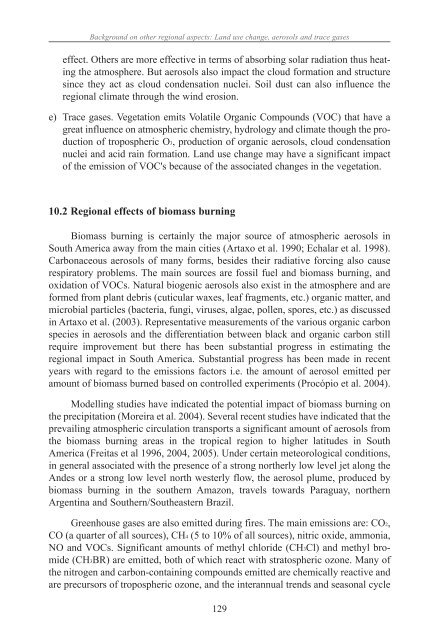chapter - Atmospheric and Oceanic Science
chapter - Atmospheric and Oceanic Science
chapter - Atmospheric and Oceanic Science
Create successful ePaper yourself
Turn your PDF publications into a flip-book with our unique Google optimized e-Paper software.
Background on other regional aspects: L<strong>and</strong> use change, aerosols <strong>and</strong> trace gases<br />
effect. Others are more effective in terms of absorbing solar radiation thus heating<br />
the atmosphere. But aerosols also impact the cloud formation <strong>and</strong> structure<br />
since they act as cloud condensation nuclei. Soil dust can also influence the<br />
regional climate through the wind erosion.<br />
e) Trace gases. Vegetation emits Volatile Organic Compounds (VOC) that have a<br />
great influence on atmospheric chemistry, hydrology <strong>and</strong> climate though the production<br />
of tropospheric O3, production of organic aerosols, cloud condensation<br />
nuclei <strong>and</strong> acid rain formation. L<strong>and</strong> use change may have a significant impact<br />
of the emission of VOC's because of the associated changes in the vegetation.<br />
10.2 Regional effects of biomass burning<br />
Biomass burning is certainly the major source of atmospheric aerosols in<br />
South America away from the main cities (Artaxo et al. 1990; Echalar et al. 1998).<br />
Carbonaceous aerosols of many forms, besides their radiative forcing also cause<br />
respiratory problems. The main sources are fossil fuel <strong>and</strong> biomass burning, <strong>and</strong><br />
oxidation of VOCs. Natural biogenic aerosols also exist in the atmosphere <strong>and</strong> are<br />
formed from plant debris (cuticular waxes, leaf fragments, etc.) organic matter, <strong>and</strong><br />
microbial particles (bacteria, fungi, viruses, algae, pollen, spores, etc.) as discussed<br />
in Artaxo et al. (2003). Representative measurements of the various organic carbon<br />
species in aerosols <strong>and</strong> the differentiation between black <strong>and</strong> organic carbon still<br />
require improvement but there has been substantial progress in estimating the<br />
regional impact in South America. Substantial progress has been made in recent<br />
years with regard to the emissions factors i.e. the amount of aerosol emitted per<br />
amount of biomass burned based on controlled experiments (Procópio et al. 2004).<br />
Modelling studies have indicated the potential impact of biomass burning on<br />
the precipitation (Moreira et al. 2004). Several recent studies have indicated that the<br />
prevailing atmospheric circulation transports a significant amount of aerosols from<br />
the biomass burning areas in the tropical region to higher latitudes in South<br />
America (Freitas et al 1996, 2004, 2005). Under certain meteorological conditions,<br />
in general associated with the presence of a strong northerly low level jet along the<br />
Andes or a strong low level north westerly flow, the aerosol plume, produced by<br />
biomass burning in the southern Amazon, travels towards Paraguay, northern<br />
Argentina <strong>and</strong> Southern/Southeastern Brazil.<br />
Greenhouse gases are also emitted during fires. The main emissions are: CO2,<br />
CO (a quarter of all sources), CH4 (5 to 10% of all sources), nitric oxide, ammonia,<br />
NO <strong>and</strong> VOCs. Significant amounts of methyl chloride (CH3Cl) <strong>and</strong> methyl bromide<br />
(CH3BR) are emitted, both of which react with stratospheric ozone. Many of<br />
the nitrogen <strong>and</strong> carbon-containing compounds emitted are chemically reactive <strong>and</strong><br />
are precursors of tropospheric ozone, <strong>and</strong> the interannual trends <strong>and</strong> seasonal cycle<br />
129






